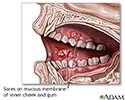Oral mucous cyst
Mucocele; Mucous retention cyst; Ranula
An oral mucous cyst is a painless, thin sac on the inner surface of the mouth. It contains clear fluid.
Causes
Mucous cysts most often appear near salivary gland openings (ducts). Common sites and causes of cysts include:
- Inner surface of the upper or lower lip, inside the cheeks, bottom surface of the tongue. These are called mucoceles. They are often caused by lip biting, lip sucking, or other trauma.
- Floor of the mouth. These are called ranula. They are caused by blockage of the salivary glands under the tongue.
Symptoms
Symptoms of mucoceles include:
- Usually painless, but can be bothersome because you're aware of the bumps in your mouth.
- Often appears clear, bluish or pink, soft, smooth, round and dome-shaped.
- Vary in size up to 0.39 inches (1 centimeter) in diameter.
- May break open on their own, but may recur.
Symptoms of ranula include:
- Usually painless swelling on the floor of the mouth below the tongue.
- Often appears bluish and dome-shaped.
- If the cyst is large, chewing, swallowing, talking may be affected.
- If the cyst grows into the neck muscle, the airway may be narrowed and breathing impaired. This is a medical emergency.
Exams and Tests
Your health care provider can usually diagnose a mucocele or ranula simply by looking at it. Other tests that may be done include:
- Biopsy
- Ultrasound
- CT scan, usually for ranula that has grown into the neck
Treatment
A mucous cyst often can be left alone. It usually will rupture on its own. If the cyst returns, it may need to be removed.
To remove a mucocele, the provider may perform any of the following:
- Freezing the cyst (cryotherapy)
- Laser treatment
- Surgery to cut out the cyst
A ranula is usually removed using a laser or surgery. Typically, the best approach is to remove both the cyst and the gland that caused the cyst.
To prevent infection and damage to the tissue, do not try to open the sac yourself. Treatment should only be done by your provider. Oral surgeons and some dentists can remove the sac.
Possible Complications
Complications may include:
- Return of the cyst
- Injury of nearby tissues during cyst removal
When to Contact a Medical Professional
Contact your provider if you:
- Notice a cyst or mass in your mouth
- Have difficulty swallowing or talking
These may be a sign of more serious problem, such as mouth cancer.
Prevention
Avoiding intentionally sucking the cheeks or biting the lips may help prevent some mucoceles.
References
Lalor L. Disorders of the mucous membranes. In: Kliegman RM, St. Geme JW, Blum NJ, et al, eds. Nelson Textbook of Pediatrics. 22nd ed. Philadelphia, PA: Elsevier; 2025:chap 705.
Patterson JW. Cysts, sinuses, and pits. In: Patterson JW, ed. Weedon's Skin Pathology. 5th ed. Philadelphia, PA: Elsevier; 2021:chap 17.
Woo BM. Sublingual gland excision and ductal surgery. In: Tiwana PS, Kademani D, eds. Atlas of Oral and Maxillofacial Surgery. 2nd ed. Philadelphia, PA: Elsevier; 2023:chap 98.
Review Date: 7/23/2024





